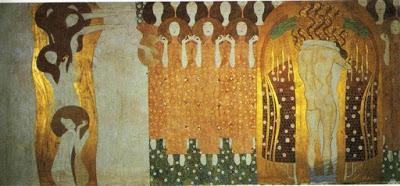by Leza Lowitz
The Longing for Happiness Finds Repose in Poetry
by Gustav Klimt
Since I’m a poet, people sometimes ask me how writing and yoga go together. Writing is a way of imbuing our lives with meaning. The grail of poetry, of writing, is self-knowledge. That’s why when we read a good poem, we feel as if the author has spoken directly to our soul, unlocked something previously unseen or hidden. This is true of yoga, too. So they naturally go together. Yoga is a moving meditation, but it's also the practice of surrender, which is an incredibly vulnerable, powerful action. If you can trust the unknown enough to fully surrender to what is, rather than looking toward a future of what could be, you begin to fully live in the moment. When you live in the moment, you realize how interconnected everything in the universe is. Through yoga, the heart opens, and everything in life begins to shift towards balance and acceptance. Like writing, yoga is also a solitary act. Even though you might practice in a group or sangha, no one can get inside your body and move your prana like you can, except for some very rare wizards and enlightened beings (but that’s another blog post). In both writing and yoga, or any creative act, it’s the quality of attention that is important. This links us to our original condition, which is sacred. Poetry and yoga are both ways to remove illusions. They are both revelatory, uncovering our original, sacred hearts and minds.As we all know by now, the word “yoga” comes from the Sanskrit word yuj, which means “yoke” or “union.” Yoga unifies the body and mind through the breath, opening channels of energy that send the life force—prana or ki—through the body. Yoga offers a way of Being rather than Doing, ultimately connecting us to our higher selves, or the Divine, or God. Yoga is a very powerful gateway into the soul; that’s why it's sometimes called the science of conscious awareness. Practicing yoga allows us to slow down, quiet the mind, and gives us a tremendous opportunity to explore our potential for growth—both physical and spiritual—and unity within ourselves and with others. The discipline of yoga is like holding up a mirror to yourself. When you do a yoga pose, your mind begins to wander. At first, you judge and compare but eventually you just release the judgments and comparisons and go deep into the breath, into the here and now. Peace, joy, acceptance, and calm arise.The practice of yoga helps us to be in the heart and the body, rather than in the “citta vrittis” of the mind. Nothing frees up the mind better than pure, pranic movement! When we get on my mat, if you’re in my head, you can’t stay there for long. Yoga takes us into the subtle body, moving through from the gross outer layer of the physical body, to the breath, to the prana, to our thoughts, and finally to action.Yoga opens up enormous channels of creativity and teaches us how to embrace the ‘process’ rather than focusing on the ‘goal.’ This has helped me greatly with my writing, and allowed me to focus more on the process, on the journey, than on the goal of a “finished product.” I know many other writers and artists have had this experience.The experience of working in a yoga pose, doing it over and over and over again to find alignment and release, not being attached to some idea or image of a “perfect pose,” helped me see that the same process in writing was not a “failure” but a necessary and important part of creativity. I came to accept the axiom that 99% of good writing is revision. I have become so much more productive in my writing since I started doing yoga. And, on good days, I find that I can be more embodied as a writer, and more poetic as a yogi. I try to write from a more embodied place due to my yoga, and I try to practice (and teach, for that matter) from a more poetic place.As a moving meditation, yoga lends itself to poetry, to creative exploration, to self-expression. We drop out of “thinking mind” and drop into a state of pure being, pure awareness, deep INNER LISTENING. Sounds a lot like poetry to me. Poets, after all, translate the world—the moon, the stars, the trees—into words. In order to translate, you have to really be aware. To look. To listen. To see.The more I practiced yoga, the more the experience of quieting down and listening to the breath, to the body, and to the silences between breaths began to resonate, and the more creativity emerged. When I first started yoga, I was struggling with my creative writing and feeling frustrated. So between writing periods, I'd do yoga to unwind. But when I released pent-up emotions and memories, yoga helped open up deeper channels of creativity and the freedom to express them. The yoga then began to encourage my creative, expressive side to emerge without judgment, and I could explore it with a sense of wonder and awe. I’m really grateful to yoga for these unexpected creative gifts.
PrasadThat sound you hear?
It’s my frozen heart melting.Bringing each drop to my lips,
I cover my body freely,wet with your name.
My lips becomeyour lips,
my body your body.
When I take you into me,
the world goes on
forever.I will
find peace in these
fragments.This pain
will be my cure.(c) Yoga Heart: Lines on the Six Perfections. Reprinted with permission of Stone Bridge Press.
You can read more about Leza's writing at www.lezalowitz.com and about her yoga studio and classes at www.sunandmoon.jp.Subscribe to Yoga for Healthy Aging by Email ° Follow Yoga for Healthy Aging on Facebook ° To order Yoga for Healthy Aging: A Guide to Lifelong Well-Being, go to Amazon, Shambhala, Indie Boundor your local bookstore.


